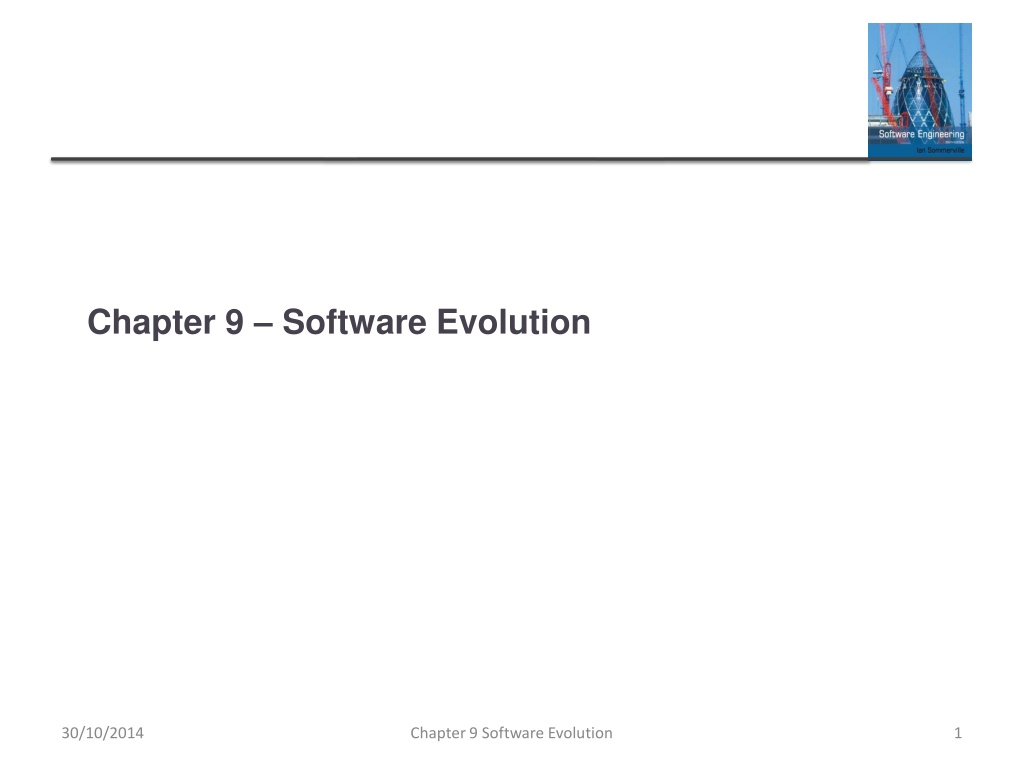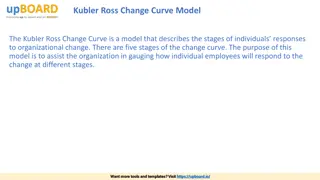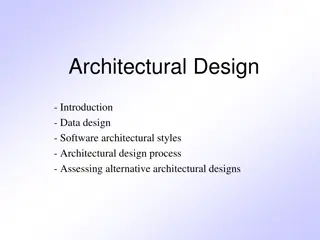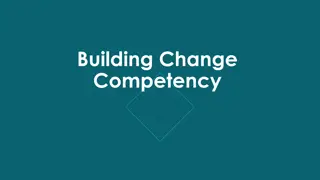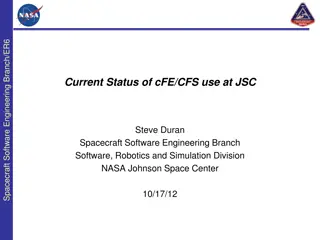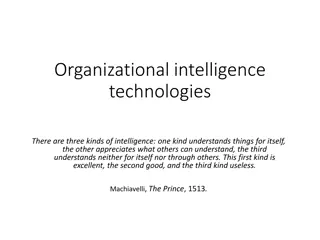Software Evolution: Managing Change and Evolution in Organizational Systems
Software evolution is an essential process for organizations to maintain the value of their critical business assets. It involves adapting to new requirements, addressing errors, and enhancing performance. The majority of software budgets in large companies are dedicated to evolving existing systems rather than developing new ones. Understanding the stages of evolution, like servicing and phase-out, is crucial for effective management of software systems.
Download Presentation

Please find below an Image/Link to download the presentation.
The content on the website is provided AS IS for your information and personal use only. It may not be sold, licensed, or shared on other websites without obtaining consent from the author. Download presentation by click this link. If you encounter any issues during the download, it is possible that the publisher has removed the file from their server.
E N D
Presentation Transcript
Chapter 9 Software Evolution 30/10/2014 Chapter 9 Software Evolution 1
Topics covered Evolution processes Legacy systems Software maintenance 30/10/2014 Chapter 9 Software Evolution 2
Software change Software change is inevitable New requirements emerge when the software is used; The business environment changes; Errors must be repaired; New computers and equipment is added to the system; The performance or reliability of the system may have to be improved. A key problem for all organizations is implementing and managing change to their existing software systems. 30/10/2014 Chapter 9 Software Evolution 3
Importance of evolution Organisations have huge investments in their software systems - they are critical business assets. To maintain the value of these assets to the business, they must be changed and updated. The majority of the software budget in large companies is devoted to changing and evolving existing software rather than developing new software. 30/10/2014 Chapter 9 Software Evolution 4
A spiral model of development and evolution 30/10/2014 Chapter 9 Software Evolution 5
Evolution and servicing 30/10/2014 Chapter 9 Software Evolution 6
Evolution and servicing Evolution The stage in a software system s life cycle where it is in operational use and is evolving as new requirements are proposed and implemented in the system. Servicing At this stage, the software remains useful but the only changes made are those required to keep it operational i.e. bug fixes and changes to reflect changes in the software s environment. No new functionality is added. Phase-out The software may still be used but no further changes are made to it. 30/10/2014 Chapter 9 Software Evolution 7
Evolution processes 30/10/2014 Chapter 9 Software Evolution 8
Evolution processes Software evolution processes depend on The type of software being maintained; The development processes used; The skills and experience of the people involved. Proposals for change are the driver for system evolution. Should be linked with components that are affected by the change, thus allowing the cost and impact of the change to be estimated. Change identification and evolution continues throughout the system lifetime. 30/10/2014 Chapter 9 Software Evolution 9
Change identification and evolution processes 30/10/2014 Chapter 9 Software Evolution 10
The software evolution process 30/10/2014 Chapter 9 Software Evolution 11
Change implementation 30/10/2014 Chapter 9 Software Evolution 12
Change implementation Iteration of the development process where the revisions to the system are designed, implemented and tested. A critical difference is that the first stage of change implementation may involve program understanding, especially if the original system developers are not responsible for the change implementation. During the program understanding phase, you have to understand how the program is structured, how it delivers functionality and how the proposed change might affect the program. 30/10/2014 Chapter 9 Software Evolution 13
Urgent change requests Urgent changes may have to be implemented without going through all stages of the software engineering process If a serious system fault has to be repaired to allow normal operation to continue; If changes to the system s environment (e.g. an OS upgrade) have unexpected effects; If there are business changes that require a very rapid response (e.g. the release of a competing product). 30/10/2014 Chapter 9 Software Evolution 14
The emergency repair process 30/10/2014 Chapter 9 Software Evolution 15
Agile methods and evolution Agile methods are based on incremental development so the transition from development to evolution is a seamless one. Evolution is simply a continuation of the development process based on frequent system releases. Automated regression testing is particularly valuable when changes are made to a system. Changes may be expressed as additional user stories. 30/10/2014 Chapter 9 Software Evolution 16
Handover problems Where the development team have used an agile approach but the evolution team is unfamiliar with agile methods and prefer a plan-based approach. The evolution team may expect detailed documentation to support evolution and this is not produced in agile processes. Where a plan-based approach has been used for development but the evolution team prefer to use agile methods. The evolution team may have to start from scratch developing automated tests and the code in the system may not have been refactored and simplified as is expected in agile development. 30/10/2014 Chapter 9 Software Evolution 17
Legacy systems 30/10/2014 Chapter 9 Software Evolution 18
Legacy systems Legacy systems are older systems that rely on languages and technology that are no longer used for new systems development. Legacy software may be dependent on older hardware, such as mainframe computers and may have associated legacy processes and procedures. Legacy systems are not just software systems but are broader socio-technical systems that include hardware, software, libraries and other supporting software and business processes. 30/10/2014 Chapter 9 Software Evolution 19
The elements of a legacy system 30/10/2014 Chapter 9 Software Evolution 20
Legacy system components System hardware Legacy systems may have been written for hardware that is no longer available. Support software The legacy system may rely on a range of support software, which may be obsolete or unsupported. Application software The application system that provides the business services is usually made up of a number of application programs. Application data These are data that are processed by the application system. They may be inconsistent, duplicated or held in different databases. 30/10/2014 Chapter 9 Software Evolution 21
Legacy system components Business processes These are processes that are used in the business to achieve some business objective. Business processes may be designed around a legacy system and constrained by the functionality that it provides. Business policies and rules These are definitions of how the business should be carried out and constraints on the business. Use of the legacy application system may be embedded in these policies and rules. 30/10/2014 Chapter 9 Software Evolution 22
Legacy system layers 30/10/2014 Chapter 9 Software Evolution 23
Legacy system replacement Legacy system replacement is risky and expensive so businesses continue to use these systems System replacement is risky for a number of reasons Lack of complete system specification Tight integration of system and business processes Undocumented business rules embedded in the legacy system New software development may be late and/or over budget 30/10/2014 Chapter 9 Software Evolution 24
Legacy system change Legacy systems are expensive to change for a number of reasons: No consistent programming style Use of obsolete programming languages with few people available with these language skills Inadequate system documentation System structure degradation Program optimizations may make them hard to understand Data errors, duplication and inconsistency 30/10/2014 Chapter 9 Software Evolution 25
Legacy system management Organisations that rely on legacy systems must choose a strategy for evolving these systems Scrap the system completely and modify business processes so that it is no longer required; Continue maintaining the system; Transform the system by re-engineering to improve its maintainability; Replace the system with a new system. The strategy chosen should depend on the system quality and its business value. 30/10/2014 Chapter 9 Software Evolution 26
Figure 9.13 An example of a legacy system assessment 30/10/2014 Chapter 9 Software Evolution 27
Legacy system categories Low quality, low business value These systems should be scrapped. Low-quality, high-business value These make an important business contribution but are expensive to maintain. Should be re-engineered or replaced if a suitable system is available. High-quality, low-business value Replace with COTS, scrap completely or maintain. High-quality, high business value Continue in operation using normal system maintenance. 30/10/2014 Chapter 9 Software Evolution 28
Business value assessment Assessment should take different viewpoints into account System end-users; Business customers; Line managers; IT managers; Senior managers. Interview different stakeholders and collate results. 30/10/2014 Chapter 9 Software Evolution 29
Issues in business value assessment The use of the system If systems are only used occasionally or by a small number of people, they may have a low business value. The business processes that are supported A system may have a low business value if it forces the use of inefficient business processes. System dependability If a system is not dependable and the problems directly affect business customers, the system has a low business value. The system outputs If the business depends on system outputs, then the system has a high business value. 30/10/2014 Chapter 9 Software Evolution 30
System quality assessment Business process assessment How well does the business process support the current goals of the business? Environment assessment How effective is the system s environment and how expensive is it to maintain? Application assessment What is the quality of the application software system? 30/10/2014 Chapter 9 Software Evolution 31
Business process assessment Use a viewpoint-oriented approach and seek answers from system stakeholders Is there a defined process model and is it followed? Do different parts of the organisation use different processes for the same function? How has the process been adapted? What are the relationships with other business processes and are these necessary? Is the process effectively supported by the legacy application software? Example - a travel ordering system may have a low business value because of the widespread use of web- based ordering. 30/10/2014 Chapter 9 Software Evolution 32
Factors used in environment assessment Factor Supplier stability Questions Is the supplier still in existence? Is the supplier financially stable and likely to continue in existence? If the supplier is no longer in business, does someone else maintain the systems? Does the hardware have a high rate of reported failures? Does the support software crash and force system restarts? How old is the hardware and software? The older the hardware and support software, the more obsolete it will be. It may still function correctly but there could be significant economic and business benefits to moving to a more modern system. Is the performance of the system adequate? Do performance problems have a significant effect on system users? Failure rate Age Performance 30/10/2014 Chapter 9 Software Evolution 33
Factors used in environment assessment Factor Support requirements Questions What local support is required by the hardware and software? If there are high costs associated with this support, it may be worth considering system replacement. What are the costs of hardware maintenance and support software licences? Older hardware may have higher maintenance costs than modern systems. Support software may have high annual licensing costs. Are there problems interfacing the system to other systems? Can compilers, for example, be used with current versions of the operating system? Is hardware emulation required? Maintenance costs Interoperability 30/10/2014 Chapter 9 Software Evolution 34
Factors used in application assessment Factor Understandability Questions How difficult is it to understand the source code of the current system? How complex are the control structures that are used? Do variables have meaningful names that reflect their function? What system documentation is available? Is the documentation complete, consistent, and current? Is there an explicit data model for the system? To what extent is data duplicated across files? Is the data used by the system up to date and consistent? Is the performance of the application adequate? Do performance problems have a significant effect on system users? Documentation Data Performance 30/10/2014 Chapter 9 Software Evolution 35
Factors used in application assessment Factor Programming language Questions Are modern compilers available for the programming language used to develop the system? Is the programming language still used for new system development? Are all versions of all parts of the system managed by a configuration management system? Is there an explicit description of the versions of components that are used in the current system? Does test data for the system exist? Is there a record of regression tests carried out when new features have been added to the system? Are there people available who have the skills to maintain the application? Are there people available who have experience with the system? Configuration management Test data Personnel skills 30/10/2014 Chapter 9 Software Evolution 36
System measurement You may collect quantitative data to make an assessment of the quality of the application system The number of system change requests; The higher this accumulated value, the lower the quality of the system. The number of different user interfaces used by the system; The more interfaces, the more likely it is that there will be inconsistencies and redundancies in these interfaces. The volume of data used by the system. As the volume of data (number of files, size of database, etc.) processed by the system increases, so too do the inconsistencies and errors in that data. Cleaning up old data is a very expensive and time-consuming process 30/10/2014 Chapter 9 Software Evolution 37
Software maintenance 30/10/2014 Chapter 9 Software Evolution 38
Software maintenance Modifying a program after it has been put into use. The term is mostly used for changing custom software. Generic software products are said to evolve to create new versions. Maintenance does not normally involve major changes to the system s architecture. Changes are implemented by modifying existing components and adding new components to the system. 30/10/2014 Chapter 9 Software Evolution 39
Types of maintenance Fault repairs Changing a system to fix bugs/vulnerabilities and correct deficiencies in the way meets its requirements. Environmental adaptation Maintenance to adapt software to a different operating environment Changing a system so that it operates in a different environment (computer, OS, etc.) from its initial implementation. Functionality addition and modification Modifying the system to satisfy new requirements. 30/10/2014 Chapter 9 Software Evolution 40
Maintenance effort distribution 30/10/2014 Chapter 9 Software Evolution 41
Maintenance costs Usually greater than development costs (2* to 100* depending on the application). Affected by both technical and non-technical factors. Increases as software is maintained. Maintenance corrupts the software structure so makes further maintenance more difficult. Ageing software can have high support costs (e.g. old languages, compilers etc.). 30/10/2014 Chapter 9 Software Evolution 42
Maintenance costs It is usually more expensive to add new features to a system during maintenance than it is to add the same features during development A new team has to understand the programs being maintained Separating maintenance and development means there is no incentive for the development team to write maintainable software Program maintenance work is unpopular Maintenance staff are often inexperienced and have limited domain knowledge. As programs age, their structure degrades and they become harder to change 30/10/2014 Chapter 9 Software Evolution 43
Maintenance prediction Maintenance prediction is concerned with assessing which parts of the system may cause problems and have high maintenance costs Change acceptance depends on the maintainability of the components affected by the change; Implementing changes degrades the system and reduces its maintainability; Maintenance costs depend on the number of changes and costs of change depend on maintainability. 30/10/2014 Chapter 9 Software Evolution 44
Maintenance prediction 30/10/2014 Chapter 9 Software Evolution 45
Change prediction Predicting the number of changes requires and understanding of the relationships between a system and its environment. Tightly coupled systems require changes whenever the environment is changed. Factors influencing this relationship are Number and complexity of system interfaces; Number of inherently volatile system requirements; The business processes where the system is used. 30/10/2014 Chapter 9 Software Evolution 46
Complexity metrics Predictions of maintainability can be made by assessing the complexity of system components. Studies have shown that most maintenance effort is spent on a relatively small number of system components. Complexity depends on Complexity of control structures; Complexity of data structures; Object, method (procedure) and module size. 30/10/2014 Chapter 9 Software Evolution 47
Process metrics Process metrics may be used to assess maintainability Number of requests for corrective maintenance; Average time required for impact analysis; Average time taken to implement a change request; Number of outstanding change requests. If any or all of these is increasing, this may indicate a decline in maintainability. 30/10/2014 Chapter 9 Software Evolution 48
Software reengineering Restructuring or rewriting part or all of a legacy system without changing its functionality. Applicable where some but not all sub-systems of a larger system require frequent maintenance. Reengineering involves adding effort to make them easier to maintain. The system may be re- structured and re-documented. 30/10/2014 Chapter 9 Software Evolution 49
Advantages of reengineering Reduced risk There is a high risk in new software development. There may be development problems, staffing problems and specification problems. Reduced cost The cost of re-engineering is often significantly less than the costs of developing new software. 30/10/2014 Chapter 9 Software Evolution 50
